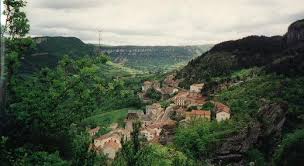 |
| Roquefort Cheese |
Roquefort is is one of three French cheeses in the running to be crowned the ultimate king of the cheeses, Brie and Epoisse being the other two. Brie, the creamy white-rind cheese, and Epoisse, the stinky but lovable wash-rind cheese, were adored by Charlemagne and Napoleon respectively, but don’t quite have the history or reputation that Roquefort has. Revered by royalty and rebels alike, Roquefort stands out among all cheeses for its distinctive look, taste and aroma. Diderot and Henry Miller even made comments about this cheese, the former calling it the finest cheese in Europe and the latter claiming that "To eat this cheese one must have genius." (By the way, Charlemagne also loved Roquefort. Which cheese he preferred, Brie or Roquefort, isn't clear.)
 |
| Roquefort, France |
I
can't mention Roquefort without bringing up the legend of how the
cheese was first made. The story, whether true or not, is not unlike a
fairy tale. Once upon a time, a young sheep-herder eating his lunch of
bread and sheep's-milk cheese became distracted by a lovely young lady.
He placed his lunch in one of the nearby caves and ran to meet the young
lass. Apparently they hit it off, because the boy didn't return for
several months. When he did, the bread from his lunch had turned moldy
and had transformed the cheese into what would later become one of the
most renowned cheeses in the world. This veiny blue-green mold in white
or yellow cheese is what gives the blues their distinctive flavor and
color.
Of course, leaving rye bread out to rot isn't a good way to consistently create the species of mold, Penicillium roqueforti,
that goes into Roquefort. In fact, in uncontrolled environments,
attempting to get this kind of mold can be dangerous -- the wrong
strains can cause hallucinations or worse.
No
matter how it was invented, the cheese unquestionably dates back
remarkably far, some say as far back as 79 CE. By 1411, Charles IV made a
stand and granted a monopoly to the people of Roquefort-Sur-Soulzon, a
small town in southern France, ensuring that the ripening of the cheese
could only take place there. In addition to the cheese ripening
throughout Roquefort-Sur-Soulzon, all Roquefort cheeses are made with
milk from the Lacaune “brebis” or ewes that live near Lacaune, a rugged
town in the Midi-Pyrenees region.
 |
| Lacaune sheep grazing in France. |
Today,
fewer than 10 companies make Roquefort cheese, and each is labeled
under Contrôlée or AOC guidelines that protect the cheese-making
process, the ingredients and the origin of a product. Look for a red
sheep or any label that specifically states Appellation D’Origine
Protegee or Garanti D’Origine et De Qualite. Some of the more renowned
companies include Societe, Papillon and Le Vieux Berger.
Gabriel
Coulet, though not the best-known of the Roquefort companies, is a
family-run business that has been in operation since 1872. The operation started when Gabriel
Coulet had plans to dig a cellar in his back yard to age a few bottles
of wine. Shortly after he began digging, he stumbled upon a fleurine, a
type of natural fault that runs through the Combalou mountain. It was at
that moment that he seized an opportunity to turn his small
cellar into a more substantial one for aging cheese.
 |
| Aging Roquefort. |
The
reason Roquefort cheese ages so well in these natural caves is that the
faults blow air either into or out of the caves as the atmospheric
pressure changes, resulting in the perfect environment in terms of
humidity and temperature. Most Roquefort cheeses are aged three to 15
months.
 |
| Roquefort on display. |
If
you haven't tried Roquefort, hold on to your chapeau. This cheese will
wake you up and call all your senses to attention with the first whiff
of its fragrant, strong aroma. Don't worry -- the odor it emits is not
like the wash-rind stinky cheeses that most people either love or hate.
This is a potent, slightly sour but pleasant smell.
 |
| Sampling the cheese. |
The cheese itself is rich and creamy with big salty, sharp, pungent and tangy flavors. This is a blue cheese like no other, and there's a reason why it's the most popular of all the blues. Stilton, Bleu D’Auvergne, Gorgonzola and Cabrales all have their strong points, but Roquefort stands out among them as a true leader. Some describe the French cheese as crumbly, which is only partly accurate. The white edges can sometimes have a drier texture that do crumble, but this isn't a hard cheese and doesn't have the characteristics of one. Both the outer edges and the veins of blue-green mold can have something of a grainy texture, but don't be concerned, as the cheese melts quickly and evenly on the tongue. The reality it that the interior is silky-smooth, especially toward the center.
Roquefort
goes with many foods and drinks. Toss it on salad, drizzle it with
honey, serve it with fruit, cook it in tarts, or serve it plain on a
crusty baguette. No matter how you serve it, you can't go wrong.
 |
| Rose goes well with Roquefort. |
The
bold flavor of Roquefort can tolerate a full-bodied red wine, but try
pairing the cheese with a rose. You won't be disappointed.




No comments:
Post a Comment